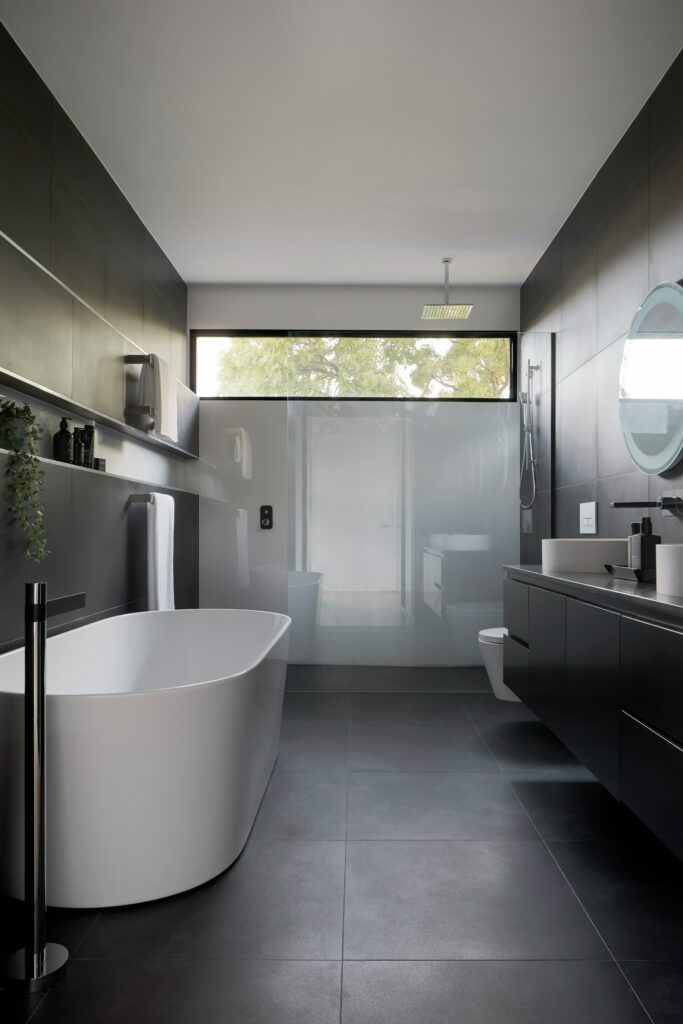Not all of us are blessed with large, airy bathrooms and when your space is particularly small, designing a room that’s practical and pretty seems like an impossible task. But there are tricks you can use in your design and layout that will make a small bathroom work better. These are just some of the features and layout ideas that are worth considering.

Photo by R ARCHITECTURE on Unsplash
Minimise clutter with a wet room
A wet room allows you to get rid of the usual bathroom clutter, including the bath and conventional shower cubicle. As there’s no need for a shower tray, tiles can be laid across the whole floor. Meaning your bathroom is going to look more spacious and clean-lined. Although you’ll still need some kind of screening, you can choose a frameless glass panel to keep the room feeling airy.
The bulk of the cost of a wet room comes from the labour, along with the tiles and tanking materials. However, the smaller the room, the less time it’ll take to fit and the fewer materials you’ll need to pay for. So, there are plusses to having a small bathroom.
Maximise space with a walk-in shower
If you don’t fancy going for a wet room, you can still minimise clutter with a walk-in style shower. Using a low-profile shower tray with a slimline edge, along with a clear glass screen, will give you the effect of a wet room without the need for tanking.
You could also try to blend the tray in with your flooring by using a matt black tray with slate flooring or a white tray with porcelain or marble tiles – giving you a high-end finish and an open feeling space. The thinner the tray the more you’re likely to pay, but this shouldn’t add more than £150 to your costs.
Free up the floor with a shower over the bath
If you really need a bath and a shower, installing your shower over the bath rather than having them separate will save you a lot of space. The smallest shower cubicles measure at least 800mm by 800mm, and these can be cramped. And considering that the average UK bathroom only measures around 2.7m by 2.3m, this isn’t a good use of space.
If you’re concerned that a shower over the bath might still feel a bit cramped to use, you could fit a P-shaped bath. This will maximise the bath width where your showerhead is positioned.
Fit in a short slipper bath
As a standard bath is typically 1700mm long, you may think a luxury freestanding or slipper bath is out of the question. But there are modern freestanding and traditional roll-top baths on the market that have a much shorter length of around 1300mm – helping you squeeze one into a small or narrow space.
These do vary in price depending on the style and finish, so you can pay anywhere between £600 and £2,500 for a short bath. However, this is a similar cost to full-size versions therefore it can still be a worthwhile option.
Save space with a cloakroom sink
Bathroom sinks can jut out quite far into a bathroom, meaning they’re difficult to position in a narrow space. Although you can’t do without a sink, you can save space by choosing a cloakroom sink over a full-size one. This can reduce the space needed by as much as 200mm, giving you more standing room. Choosing a wall-hung sink over a traditional pedestal sink will also help you claw back some floorspace.
Not all cloakroom sinks have a lot of room around the edge for soap dispensers and toothbrush holders but to combat this issue, you could choose wall-mounted accessories or pop a narrow shelf above the sink.
Keep it compact with a close couple toilet
Picking a toilet with a cistern that sits on the back of the pan will help you save more floor space compared to conventional toilets. Short-pan toilets typically have a depth of around 600mm to 650mm, which can save you another 100mm of floor space.
Wall-hung toilets can also be compact. However, they do need a panel building to house the cistern, so they can be slightly more complex to install. If your bathroom is small, fitting can be awkward and time-consuming. To ensure you make the right choice, it’s a good idea to get advice from a bathroom designer or tradesperson first.
Ditch the radiator for underfloor heating
Underfloor heating not only adds a touch of luxury to your tiny bathroom, but it also frees up more space. Not having to leave wall space for a radiator also helps improve the flexibility of your bathroom design.
Electric underfloor heating is typically the easiest to install, but you need to insulate the floor to ensure it isn’t too costly to run. Heating mats tend to be the most straightforward to put down, but a loose wire system may be better if the space is awkwardly shaped. Either way, you’ll need an electrician or heating engineer to ensure it’s done correctly and safely.







Leave a Reply